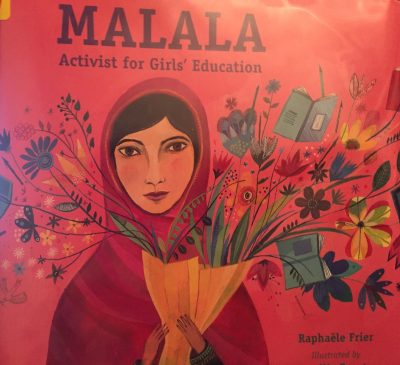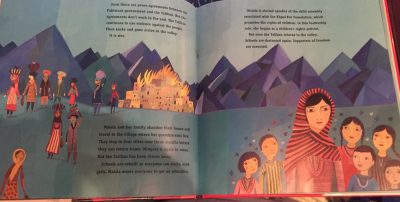- Title: Malala: Activist for Girls’ Education
- Author(s): Raphaele Frier
- Illustrator/Photographer: Aurelia Fronty

- Publisher and Year: Charlesbridge, 2017
- Number of pages: 35
- Tags: Diversity, Family, Culture, Emotion, 6-8, Picture Book, Morgan Houk
- Genre: Non-Fiction
- Analysis:

The plot of this book tells the true story of a young girl growing up in Pakistan named Malala Yousafzai. A group called the Taliban took over the village in which Malala and her family lived and put a ban on all girls attending school which they enforced through violence and, in many cases, death. Malala’s father owned a school for girls so they knew the importance of an education and began speaking out against the Taliban as activists. Malala and her father were soon targeted by the Taliban and Malala was shot in the head on her school bus. She somehow survived the attack and went on to speak on bigger platforms advocated for girls’ education throughout the world. Malala ended up winning the Nobel Peace Prize and the Taliban no longer has complete rule over her village.
This story could definitely act as a mirror for children who identify as Muslim. I have not seen very many books that incorporate Islam in some way and I think this story does a great job of capturing the many different interpretations of the religion. For many children in the United States, this book will act as a window into Pakistani culture and into the lives of a family that lives on the other end of the world. Most of all, this book will act as a door to activism and speaking up for what you believe in. This book shows how the voice of one, young girl has the power to change the world and that is a very important concept that the children of today need to be aware of.
The ideological framework in the story shows a shift in power. In the beginning of the story, the Pakistani people are illustrated in dark colors and very small while the Taliban are above them, flying overhead in planes. The Taliban held the power during this time in the story but as soon as Malala begins speaking out on public platforms and gaining followers, the power shifted. This is shown by the villagers clothes becoming more colorful and vibrant and they are pictured closer to the frame making them look much larger.
The illustrations look as though they were painted with acrylics. The colors used are very bright and objects, such as the mountains and the buildings, were painted abstractly using basic shapes like triangles and squares.
There are a lot of special features to this book that make it that much more interesting. At the back of the book, there is a real photograph of Malala as she was accepting her Nobel Peace Prize and the page has several inspirational quotes regarding activism and education. The next page is titled Malala, Her People, and Her Country. This page gives a basic timeline of the events of Malala’s story as well as a map of Pakistan and information about the country. The following page is titled Girls and School and it goes a little more in depth about the alarming situation for girls in Pakistan. It also talks about the disparities in girl’s education all over the world. This page is accompanied by real photographs of Pakistani girls in school. The next page is very crucial because it talks about Malala’s interpretation of her Islamic faith and how the majority of Muslims share similar views. Lastly, the book has a page dedicated to all of the former activists that inspire Malala.
